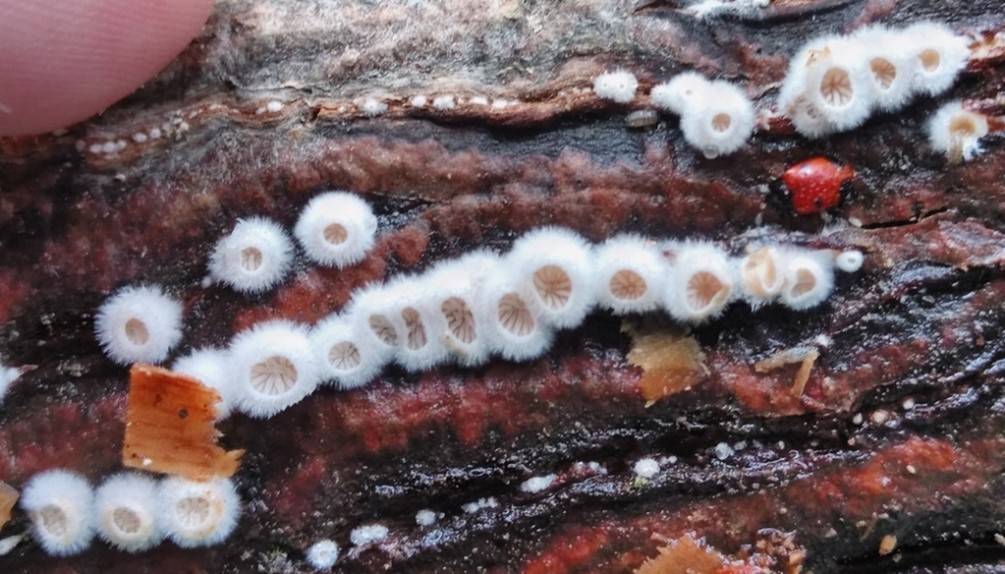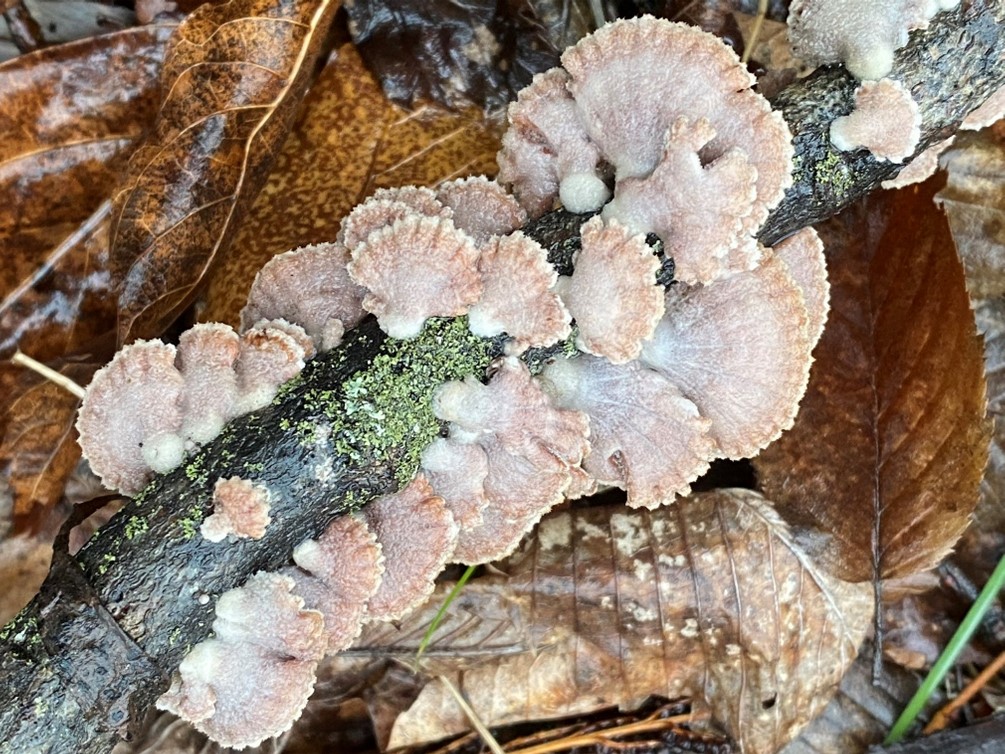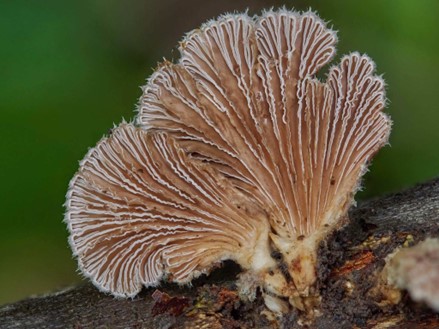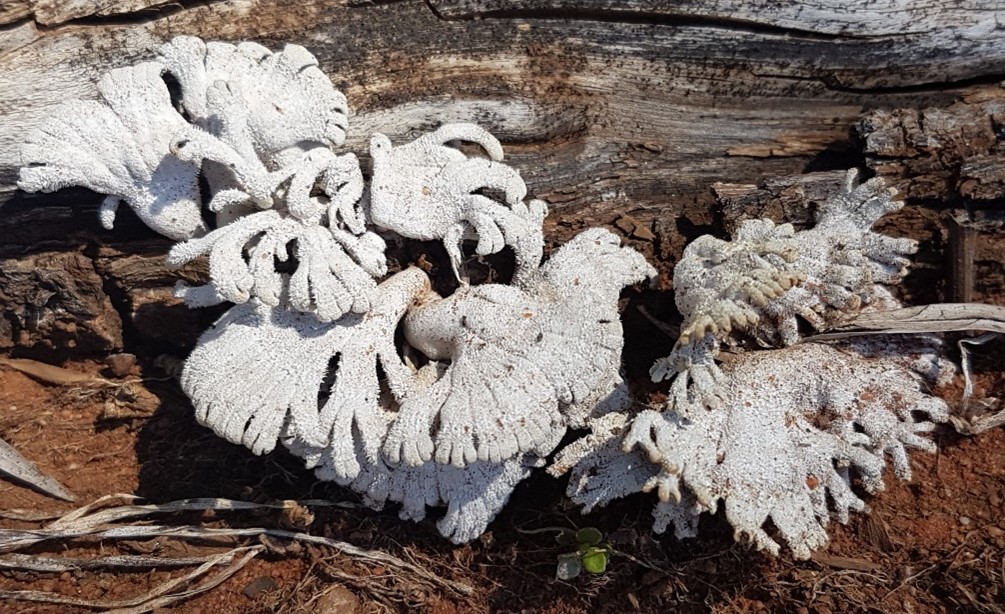ເລກລຳດັບທີ: 129
ລະດັບການຮວບຮວມຂໍ້ມູນ: ເກີອບສົມບູນ
ປັບປູງຄັ້ງລ່າສຸດ: 2024-10-15
ເຫັດບີ້
Split Gill Mushroom
Schizophyllum commune Fr.
ເຊື້ອເຫັດ
ເຊື້ອຣາເກີດຕາມໄມ້
×
ຊື່ທ້ອງຖີ່ນ:
ເຫັດຕີນກັບແກ້ (Het theen kab khae ), ເຫັດຕີນກັບແກ້ (Het kab kae), ເຫັດເຂົ້າຕອກ (Het khao tok) ( Common Porecrust, Split Gill Fungus, Splitgill, Common Porecrust)
ຊື່ພ້ອງ
:
Agaricus alneus L.
Agaricus alneus Reichard
Agaricus multifidus Batsch
Agaricus villosocanescens Baumg.
Apus alneus (L.) Gray
Daedalea commune (Fr.) P.Kumm.
Hyponevris alneus (L.) Earle
Merulius alneus (L.) J.F.Gmel.
Merulius alneus Schumach.
Merulius communis (Fr.) Spirin & Zmitr.
Pleuropus alneus (L.) Zawadzki
Scaphophoeum agaricoides Ehrenb.
Scaphophoeum agaricoides Ehrenb. ex Wallr.
Scaphophorum agaricoides Ehrenb.
Schizophyllum alneum (L.) J.Schröt.
Schizophyllum alneum (Reichard) Kuntze, 1898
Schizophyllum alneum f. radiatum Pilát
Schizophyllum alneum var. multifida (Batsch) Fr.
Schizophyllum alneum var. multifida (Batsch) Fr. ex Sacc.
Schizophyllum commune f. stipitatum L.Krieg.
Schizophyllum commune subsp. multifidum (Batsch) Cooke, 1892
Schizophyllum commune var. longii Parisi
Schizophyllum commune var. multifidum (Batsch) Cooke
Schizophyllum commune var. palmatum Debeaux
Schizophyllum multifidum (Batsch) Fr.
Schizophyllum multifidum var. digitatum Ellis & T.Macbr.
Schizophyllus communis Fr.
Agaricus alneus Reichard
Agaricus multifidus Batsch
Agaricus villosocanescens Baumg.
Apus alneus (L.) Gray
Daedalea commune (Fr.) P.Kumm.
Hyponevris alneus (L.) Earle
Merulius alneus (L.) J.F.Gmel.
Merulius alneus Schumach.
Merulius communis (Fr.) Spirin & Zmitr.
Pleuropus alneus (L.) Zawadzki
Scaphophoeum agaricoides Ehrenb.
Scaphophoeum agaricoides Ehrenb. ex Wallr.
Scaphophorum agaricoides Ehrenb.
Schizophyllum alneum (L.) J.Schröt.
Schizophyllum alneum (Reichard) Kuntze, 1898
Schizophyllum alneum f. radiatum Pilát
Schizophyllum alneum var. multifida (Batsch) Fr.
Schizophyllum alneum var. multifida (Batsch) Fr. ex Sacc.
Schizophyllum commune f. stipitatum L.Krieg.
Schizophyllum commune subsp. multifidum (Batsch) Cooke, 1892
Schizophyllum commune var. longii Parisi
Schizophyllum commune var. multifidum (Batsch) Cooke
Schizophyllum commune var. palmatum Debeaux
Schizophyllum multifidum (Batsch) Fr.
Schizophyllum multifidum var. digitatum Ellis & T.Macbr.
Schizophyllus communis Fr.
ຊື່ສະກຸນ:
Schizophyllaceae
ຊະນິດໃກ້ຄຽງ:
ບັນຍາຍລັກສະນະທາງພືດສາດ:
ເຫັດຊະນິດນີ້ມີຮູບຮ່າງຄ້າຍເຮືອ ເຊິ່ງມີລັກສະນະພິເສດຫຼາຍ ຄື ໂດຍຈະອອກເປັນກຸ່ມຫຼາຍ ອອກຕິດກັນເປັນແນວຍາວ, ມີຂອບຄ້າຍເຮືອ, ເມື່ອຢູ່ໃນທີ່ແຫ້ງ ຂອບຈະໂຄ້ງເຂົ້າດ້ານໃນ ແຕ່ເມື່ອໄດ້ຮັບຄວາມຊຸ່ມຂອບຈະຊື່ຂື້ນ ເຮັດໃຫ້ເຫັດຊະນິດນີ້ມີລັກສະນະຄ້າຍເງືອກ ມີແສກຕາມຍາວ.
ເຫັດບີ້ບໍ່ມີກ້ານ ເຊິ່ງຖືວ່າຜິດປົກກະຕິເມື່ອທຽບກັບເຫັດຊະນິດອື່ນ.
ໝວກເຫັດບີ້ມີລັກສະນະເປັນຂົນຟູ ສີຂາວຈົນຮອດສີນ້ຳຕານເທົາ, ມີຂະໜາດກວ້າງ 10 ຫາ 15 ມມ. ມີສ່ວນທີ່ຊ່ວຍຍຶດຕິດແຕ່ລະແສກໄວ້.
ສະປໍມີສີຂາວ.
ແຫຼ່ງທີ່ມາ: [1]
ເຫັດບີ້ບໍ່ມີກ້ານ ເຊິ່ງຖືວ່າຜິດປົກກະຕິເມື່ອທຽບກັບເຫັດຊະນິດອື່ນ.
ໝວກເຫັດບີ້ມີລັກສະນະເປັນຂົນຟູ ສີຂາວຈົນຮອດສີນ້ຳຕານເທົາ, ມີຂະໜາດກວ້າງ 10 ຫາ 15 ມມ. ມີສ່ວນທີ່ຊ່ວຍຍຶດຕິດແຕ່ລະແສກໄວ້.
ສະປໍມີສີຂາວ.
ແຫຼ່ງທີ່ມາ: [1]
ນິເວດວິທະຍາ
ເຂດກະຈາຍພັນທົ່ວໂລກ:
Schizophyllum commune is not native to a single country it is a cosmopolitan species, meaning it naturally occurs on every continent except Antarctica. [8]
ເຫັດບີ້ເປັນເຫັດທີ່ບໍ່ແມ່ນຊະນິດພື້ນເມືອງຂອງປະເທດໃດໜຶ່ງ ແຕ່ເປັນສາຍພັນທົ່ວໄປທີ່ແຜ່ຫຼາຍທົ່ວໂລກ ເຊິ່ງໝາຍຄວາມວ່າພົບໄດ້ຕາມທຳມະຊາດທຸກທະວີບ ຍົກເວັ້ນ ແອນຕາຕິກາ. [8]
Global distribution of the Schizophyllum commune between 2004 to 2024 Source: [2]
ເຂດກະຈາຍພັນທົ່ວໂລກຂອງເຫັດບີ ໃນລະຫວ່າງປີ 2004 ຫາ 2024. ແຫຼ່ງທີ່ມາ: [2]
ເຫັດບີ້ເປັນເຫັດທີ່ບໍ່ແມ່ນຊະນິດພື້ນເມືອງຂອງປະເທດໃດໜຶ່ງ ແຕ່ເປັນສາຍພັນທົ່ວໄປທີ່ແຜ່ຫຼາຍທົ່ວໂລກ ເຊິ່ງໝາຍຄວາມວ່າພົບໄດ້ຕາມທຳມະຊາດທຸກທະວີບ ຍົກເວັ້ນ ແອນຕາຕິກາ. [8]
Global distribution of the Schizophyllum commune between 2004 to 2024 Source: [2]
ເຂດກະຈາຍພັນທົ່ວໂລກຂອງເຫັດບີ ໃນລະຫວ່າງປີ 2004 ຫາ 2024. ແຫຼ່ງທີ່ມາ: [2]
ເຂດກະຈາຍພັນໃນລາວ
:
ເຂດພູສູງພາກເໜືອຂອງລາວ
ລຽບແມ່ນ້ຳຂອງພາກເໜືອ
ເຂດພູສູງສາຍພູຫຼວງ ແລະ ເຂດພູພຽງແຂວງຊຽງຂວາງ
ທົ່ງພຽງວຽງຈັນ
ເຂດສາຍພູຫຼວງພາກເໜືອ
ເຂດສາຍພູຫຼວງຕອນລຸ່ມ
ສາຍພູຫຼວງພາກໃຕ້
ເຂດລຽບແມ່ນ້ຳຂອງພາກໃຕ້
ພູພຽງບໍລິເວນ
ເຂດສາຍພູຫຼວງພາກກາງ
ລຽບແມ່ນ້ຳຂອງພາກເໜືອ
ເຂດພູສູງສາຍພູຫຼວງ ແລະ ເຂດພູພຽງແຂວງຊຽງຂວາງ
ທົ່ງພຽງວຽງຈັນ
ເຂດສາຍພູຫຼວງພາກເໜືອ
ເຂດສາຍພູຫຼວງຕອນລຸ່ມ
ສາຍພູຫຼວງພາກໃຕ້
ເຂດລຽບແມ່ນ້ຳຂອງພາກໃຕ້
ພູພຽງບໍລິເວນ
ເຂດສາຍພູຫຼວງພາກກາງ

ເຂດກະຈາຍພັນຕາມພູມສັນຖານ
:
ປ່າດົງດິບ
ປ່າປະສົມປ່ຽນໃບ
ປ່າໂຄກ
ປ່າແປກ
ປ່າແປກປະສົມປ່າໃບກ້ວາງ
ເຂດຜະລິດພືດຜົນເນີນສູງ
ປ່າເຫຼົ່າອ່ອນ
ປ່າເຫຼົ່າແກ່
ປ່າປະສົມປ່ຽນໃບ
ປ່າໂຄກ
ປ່າແປກ
ປ່າແປກປະສົມປ່າໃບກ້ວາງ
ເຂດຜະລິດພືດຜົນເນີນສູງ
ປ່າເຫຼົ່າອ່ອນ
ປ່າເຫຼົ່າແກ່
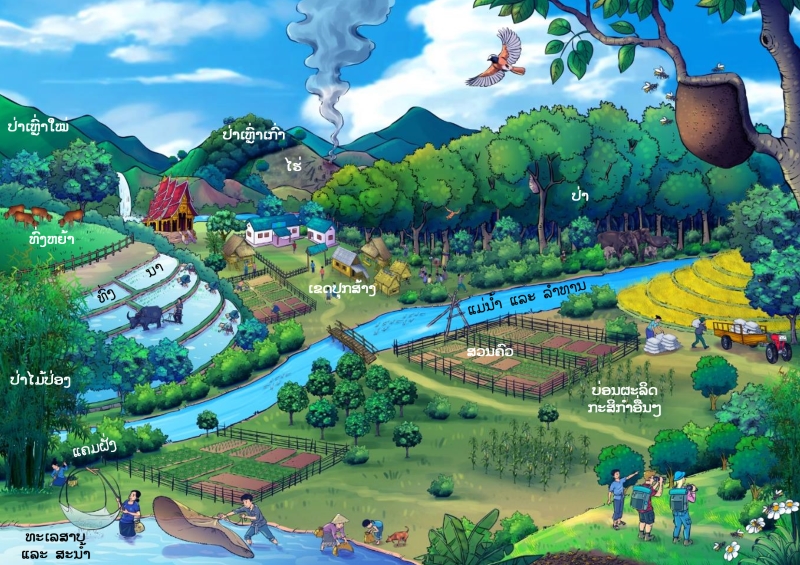
ສະເພາະຖິ່ນໃນລາວ:
ພື້ນເມືອງ
ຮຸກຮານ
:
ບໍ່ຮຸກຮານ
ສະຖານະພາບການອະນູຮັກ IUCN
:
ບໍ່ມີຄວາມສ່ຽງ
ສະຖານະພາບການອະນຸຮັກແຫ່ງຊາດລາວ
:
ບໍ່ຖືກລະບຸໃນບັນຊີປະເພດໃດ
ການນຳໃຊ້
ປະເພດການນຳໃຊ້:
ອາຫານ
ພືດເປັນຢາ
ພືດເປັນຢາ
ບັນຍາຍການນຳໃຊ້:
ອາຫານ: ເຫັດຊະນິດນີ້ໃຊ້ເຮັດແກງໄດ້ ໂດຍຈະມີຣົດຊາບທີ່ເຂັ້ມຂຸ້ນ ແລະ ກົມກອ່ມ ເຊິ່ງເຂົ້າກັບ່ວນປະສົມຕ່າງໆໄດ້ດີ [3]. ເຫັດບີ້ມັກພົບເຫັນຂາຍທົ່ວໄປໃນຕະຫຼາດທ້ອງຖິ່ນຂອງລາວ ເຖິ່ງວ່າຈະມີເນື້ອສຳພັດທີ່ໜຽວ ແຕ່ກໍມີຣົດຊາດດີ ມັກນຳມາຊັບໃຫ້ລະອຽດ ແລ້ວໃຊ້ແກງ ຫຼື ຂົ້ວ ເນື່ອງຈາກມີເສັ້ນໃຍແບບພິເສດຈຶ່ງເໝາະແກ່ການເຮັດແກງ. [6]
ຢາ: ເຫັດບີ້ມີຄຸນຄ່າທາງດ້ານໂພຊະນາການ ແລະ ຄຸນສົມບັດທາງສະໝຸນໄພອີກປະການໜຶ່ງ [1]. ນອກເໜືອຈາການນໍາມາປະກອບອາຫານ ເຫັດບີ້ຍັງໄດ້ຮັບການຍອມຮັບ ໃນຄຸນສົມບັດທາງດ້ານສະໝຸນໄພອີກດ້ວຍ ເຊິ່ງປະກອບດ້ວຍສານທີ່ອອກລິດທາງຊີວະພາບ ເຊິ່ງສາມາດຊວຍເສີມສ້າງລະບົບພູມຄຸ້ມກັນ, ຊ່ວຍຕ້ານອານຸມູນອິດສະ ແລະ ຕ້ານຈຸລິນຊີ ເຊິ່ງຄຸນສົມບັດເຫຼົ່ານີ້ເປັນສ່ວນທີ່ນຳໄປໃຊ້ເຂົ້າໃນທາງການຢາພື້ນບ້ານຂອງລາວ ແລະ ປະເທດອື່ນໆ ໃນອາຊີຕາເວັນອອກສຽງໃຕ້. [4], [5]
ຢາ: ເຫັດບີ້ມີຄຸນຄ່າທາງດ້ານໂພຊະນາການ ແລະ ຄຸນສົມບັດທາງສະໝຸນໄພອີກປະການໜຶ່ງ [1]. ນອກເໜືອຈາການນໍາມາປະກອບອາຫານ ເຫັດບີ້ຍັງໄດ້ຮັບການຍອມຮັບ ໃນຄຸນສົມບັດທາງດ້ານສະໝຸນໄພອີກດ້ວຍ ເຊິ່ງປະກອບດ້ວຍສານທີ່ອອກລິດທາງຊີວະພາບ ເຊິ່ງສາມາດຊວຍເສີມສ້າງລະບົບພູມຄຸ້ມກັນ, ຊ່ວຍຕ້ານອານຸມູນອິດສະ ແລະ ຕ້ານຈຸລິນຊີ ເຊິ່ງຄຸນສົມບັດເຫຼົ່ານີ້ເປັນສ່ວນທີ່ນຳໄປໃຊ້ເຂົ້າໃນທາງການຢາພື້ນບ້ານຂອງລາວ ແລະ ປະເທດອື່ນໆ ໃນອາຊີຕາເວັນອອກສຽງໃຕ້. [4], [5]
ການປູກ ການລ້ຽງ:
ຊະນິດທຳມະຊາດ
ລະດູການເກັບກູ້:
ເມສາ
ພຶກສະພາ
ມິຖຸນາ
ກໍລະກົດ
ສິງຫາ
ພຶກສະພາ
ມິຖຸນາ
ກໍລະກົດ
ສິງຫາ
ການຕະຫຼາດ ແລະ ຕ່ອງໂສ້ມູນຄ່າ:
N/A
ການຄຸ້ມຄອງຈັດການ
ພື້ນທຳສຳຄັນ: ພື້ນທີ່ສຳຄັນຂອງເຫັດຊະນິດນີ້ຫາກຕ້ອງການເກັບກ່ຽວ ແມ່ນໄຮ່, ປ່າເຫຼົ່າອ່ອນ ແລະ ປ່າເຫຼົ່າແກ່. [9]
ອຸປະກອນໃນການເກັບກ່ຽວເຫັດຊະນິດມີ ກະຕ່າ, ມີດ ຫຼື ພ້າ ແລະ ເປົາ. [9]
ອຸປະກອນໃນການເກັບກ່ຽວເຫັດຊະນິດມີ ກະຕ່າ, ມີດ ຫຼື ພ້າ ແລະ ເປົາ. [9]
ໂພຊະນາການ
ຄຸນຄ່າທາງໂພຊະນາການ:
ແຫຼ່ງເສັ້ນໃຍທີ່ສຳຄັນ
ບັນຍາຍຄຸນຄ່າທາງໂພຊະນາການ:
ເຫັດຊະນິດນີ້ໄດ້ຮັບຄວາມສົນໃຈໃນຖານະສ່ວນປະກອບທີ່ມີປະໂຫຍດ ເນື່ອງມີເຄຣໍລີ້ຕ່ຳ, ມີວິຕາມິນ, ແຮ່ທາດ ແລະ ໂປຣຕີນສູງ. [5]
| ສານອາຫານ | /100g | ໝາຍເຫດ |
|---|---|---|
| ໂປຣຕີນ | 18.83 | N/A |
| ຄາໂບໄຮເດຣດ | 66.06 | N/A |
| ໄຂມັນ | 3.45 | N/A |
| ວິຕາມິນ | N/A | N/A |
| ແຮ່ທາດ | N/A | Phosphorus 408 mg, Magnesium 227 mg, Calcium 188 mg, Iron 12.3 mg, Zinc 5.7 mg, Cop-per 0.9 mg, Nitrogen 1.54 mg, Sodium 0.375 mg, Ascorbic acid 0.49 mg, Niacin 8.29 mg, Riboflavin 0.89 mg, Thiamine 0.29 mg and Folic acid 0.27 mg. |
| ເສັ້ນໄຍ | 68 | N/A |
ອ້າງອິງ
ເຄດິດຮູບພາບ:
[1] iNaturalist [Online]. Uploaded in October 2018 by: Whitney Mattila. Available: https://www.inaturalist.org/observations/17541361. [Accessed: 24 April 2025]
[2] iNaturalist [Online]. Uploaded on 02 February 2022 by: Meg Mad-den. Available: https://www.inaturalist.org/observations/106021947. [Accessed: 24 April 2025]
[3] iNaturalist [Online]. Uploaded on 08 July 2019 by: Philip Herbst. Available: https://www.inaturalist.org/observations/28393158. [Accessed: 24 April 2025]
[4] iNaturalist [Online]. Uploaded on September 2017 by: gogga. Available: https://www.inaturalist.org/observations/8136009. [Accessed: 24 April 2025]
[2] iNaturalist [Online]. Uploaded on 02 February 2022 by: Meg Mad-den. Available: https://www.inaturalist.org/observations/106021947. [Accessed: 24 April 2025]
[3] iNaturalist [Online]. Uploaded on 08 July 2019 by: Philip Herbst. Available: https://www.inaturalist.org/observations/28393158. [Accessed: 24 April 2025]
[4] iNaturalist [Online]. Uploaded on September 2017 by: gogga. Available: https://www.inaturalist.org/observations/8136009. [Accessed: 24 April 2025]
ອ້າງອິງ:
[4] "An Introduction to the Edible, Poisonous, and Medicinal Plants of Northern Laos," Ministry of Agriculture and Forestry, 2020. [Online]. Available: https://bei.maf.gov.la/wp-content/uploads/2020/11/An-Introduction-to-the-Edible-Poisonous-and-Medicial-of-the-Nortern-Lao2020.pdf. [Ac-cessed: Oct. 8, 2024].
[5] "Schizophyllum commune Fr.," Global Biodiversity Information Facility, [Online]. Available: https://www.gbif.org/species/5241128. [Accessed: Oct. 8, 2024].
[6] T. Albina, J. Kaur, and V. Bhadariya, "Schizophyllum commune: A Promising Functional Ingredient for Food and Medicine," Journal of Food Chemistry & Nanotechnology, vol. 9, no. 1, 2020. [Online]. Available: https://foodchemistryjournal.com/jfcn/articles/v9s1/jfcn-s1-takhelmayum-albina.pdf. [Accessed: Oct. 8, 2024].
[7] A. Takhelmayum, "Optimal Power Flow and Performance Analysis of SPV Penetration to IEEE Bus System Using MI Power," Journal of Electrical Systems, vol. 9, no. 1, pp. 1-10, 2023. [Online]. Available: https://journal.esrgroups.org/jes/article/view/3958/2912. [Accessed: Oct. 8, 2024].
[8] J. Hobbs, "Chemistry, Nutritional Value, Immunopharmacology, and Safety of Schizophyllum commune," International Journal of Medicinal Mushrooms, vol. 7, no. 1, pp. 1-10, 2005. [Online]. Available: file:///C:/Users/duang/Downloads/Hobbs2005.ChemistryNutritionalValueImmunopharmacologySafetyofSchizophyllumcom-muneIJMMPublishedcopy.pdf. [Accessed: Oct. 8, 2024].
[9] A. M. M. Alshahrani, A. A. Alshahrani, and M. A. Alshahrani, "Schizophyllum commune: A Comprehensive Review of Its Nutritional and Medicinal Properties," International Journal of Molecular Sciences, vol. 23, no. 14, p. 14766, 2022. [Online]. Available: https://www.ncbi.nlm.nih.gov/pmc/articles/PMC9740160/pdf/ijms-23-14766.pdf. [Accessed: Oct. 8, 2024].
[10] "ຂົ້ວເຫັດບີ້ໃສ່ໄຂ່" Pha Khao Lao, 2024. [Online]. Available: https://www.phakhaolao.la/stories/%E0%BA%82%E0%BA%BB%E0%BB%89%E0%BA%A7%E0%BB%80%E0%BA%AB%E0%BA%B1%E0%BA%94%E0%BA%9A%E0%BA%B5%E0%BB%89%E0%BB%83%E0%BA%AA%E0%BB%88%E0%BB%84%E0%BA%82%E0%BB%88. [Accessed: Oct. 14, 2024].
[5] "Schizophyllum commune Fr.," Global Biodiversity Information Facility, [Online]. Available: https://www.gbif.org/species/5241128. [Accessed: Oct. 8, 2024].
[6] T. Albina, J. Kaur, and V. Bhadariya, "Schizophyllum commune: A Promising Functional Ingredient for Food and Medicine," Journal of Food Chemistry & Nanotechnology, vol. 9, no. 1, 2020. [Online]. Available: https://foodchemistryjournal.com/jfcn/articles/v9s1/jfcn-s1-takhelmayum-albina.pdf. [Accessed: Oct. 8, 2024].
[7] A. Takhelmayum, "Optimal Power Flow and Performance Analysis of SPV Penetration to IEEE Bus System Using MI Power," Journal of Electrical Systems, vol. 9, no. 1, pp. 1-10, 2023. [Online]. Available: https://journal.esrgroups.org/jes/article/view/3958/2912. [Accessed: Oct. 8, 2024].
[8] J. Hobbs, "Chemistry, Nutritional Value, Immunopharmacology, and Safety of Schizophyllum commune," International Journal of Medicinal Mushrooms, vol. 7, no. 1, pp. 1-10, 2005. [Online]. Available: file:///C:/Users/duang/Downloads/Hobbs2005.ChemistryNutritionalValueImmunopharmacologySafetyofSchizophyllumcom-muneIJMMPublishedcopy.pdf. [Accessed: Oct. 8, 2024].
[9] A. M. M. Alshahrani, A. A. Alshahrani, and M. A. Alshahrani, "Schizophyllum commune: A Comprehensive Review of Its Nutritional and Medicinal Properties," International Journal of Molecular Sciences, vol. 23, no. 14, p. 14766, 2022. [Online]. Available: https://www.ncbi.nlm.nih.gov/pmc/articles/PMC9740160/pdf/ijms-23-14766.pdf. [Accessed: Oct. 8, 2024].
[10] "ຂົ້ວເຫັດບີ້ໃສ່ໄຂ່" Pha Khao Lao, 2024. [Online]. Available: https://www.phakhaolao.la/stories/%E0%BA%82%E0%BA%BB%E0%BB%89%E0%BA%A7%E0%BB%80%E0%BA%AB%E0%BA%B1%E0%BA%94%E0%BA%9A%E0%BA%B5%E0%BB%89%E0%BB%83%E0%BA%AA%E0%BB%88%E0%BB%84%E0%BA%82%E0%BB%88. [Accessed: Oct. 14, 2024].
ຜູ້ສ້າງ Factsheet:
ຜູ້ກວດສອບ Factsheet:
,
